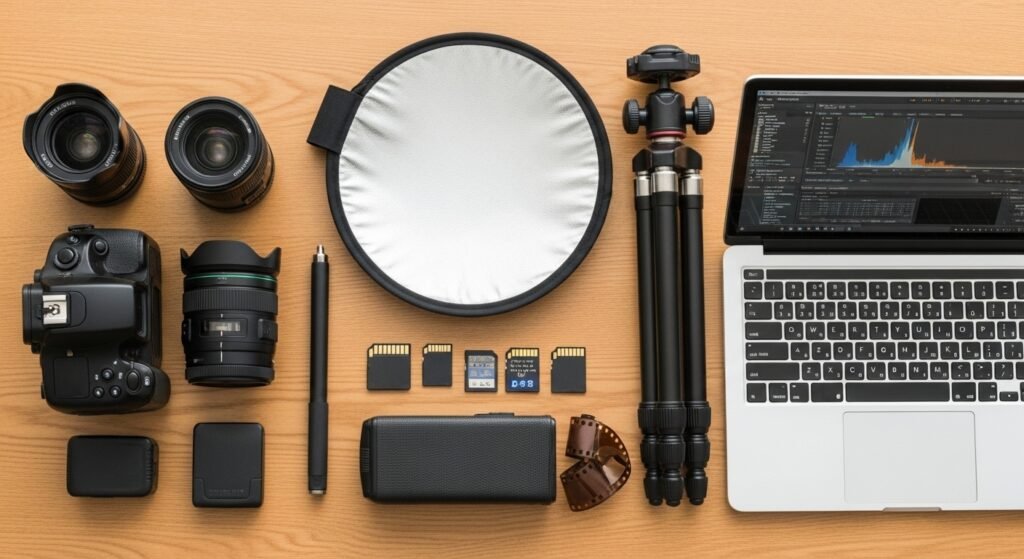If you’ve been typing into Google: how to start a photography business, how much money do you need to start a photography business, how do I start a photography business legally with not much money, tips on starting your own photography business from home, is photography profitable, how much money do photographers make, and the list goes on…. Well, you’re in the right place. It can feel totally overwhelming when you don’t have a mentor, or gear, or any clue where to even begin.
But here’s the good news: you don’t need every shiny gadget to start. You don’t need to make everything perfect from day one. You can start lean, legal, and with minimal funds, and grow as you go. We have pulled together a step-by-step roadmap (with lots of budget-friendly advice) to help you launch your photography business the cheap way—and do it right.
Step-by-Step Guide On How To Start A Photography Business
If you want to learn how to start a photography business with no experience, the following steps will help you plan, strategize, and achieve success in a short time. Let’s get into it!
Step 1: Plan and Strategize
Before you buy a camera or design a logo, get clear on what you will offer and how you’ll run it.
- Choose Your Niche
Think: what type of photography do you want to specialize in? Portraits, family sessions, product photography, weddings, events, travel, commercial? Pick one (or two) to start.

Having a niche helps your messaging, your target audience, and your marketing.
Also search: how to start a photography business with no experience. Starting simple (say portraits or home-business product shots) means you can practice, learn, and improve.
- Conduct Market Research
Look around your area (or online if you plan remote work). What are other photographers charging? What niches are oversaturated? And what gaps can you fill?
This ties into how to grow a photography business later: knowing the market helps you position yourself smartly.
- Write a Simple Business Plan
It doesn’t need to be 50 pages. Do this:
- Define your services (e.g., “two-hour family session with 30 edited digital images”).
- Estimate startup costs (gear, website, register fee, marketing).
- Draft your pricing.
- Choose marketing methods (social media, referrals, local networking).
- Outline how you’ll track and grow.
- Pick Your Business Name
Don’t overthink this. Many successful photographers use their name + “Photography”. Using your legal name protects you (you own your name) and keeps it simple.
Check domain availability and social media handles while you’re at it (you’ll need them for Step 3).
Step 2: Handle the Legal & Financial Setup
This is the least fun part, I get it. But it’s critical. Skip this and you’ll regret it later. So do it early, do it cheap, move on.

- Register Your Business
Depending on your country or region, you’ll have varying rules. In many places, you can start as a sole proprietor or register a DBA (“Doing Business As”). Alternatively, you might register an LLC for more protection. Guides say that for new photographers earning under a threshold and doing low-risk work, a sole proprietorship or DBA is perfectly fine.
Fee: typically modest. The cheaper version is fine at first.
- Contracts, Insurance, and Releases
Even low-budget businesses need basic contracts for every shoot. A simple contract helps you avoid misunderstandings and protects you.
Check whether you need liability insurance and gear insurance. The cost may be modest (for small budgets), but the peace of mind is worth it.
Also, understand model releases if you shoot people and plan to publish or sell images: image rights matter.
Step 3: Brand, Website & Online Presence (With Minimal Spend)
Once the legal stuff is done, you get to have fun, but do it smartly so you don’t overspend.
- Create Your Brand Look
You don’t need to hire a designer if you’re low on funds. Use a free tool like Canva to make a simple logo, pick two brand colors, and set your style of photography. Keep it consistent.
But don’t over‐delay this. Get it done and move on.
- Set Up a Website
Having a website helps you be found when people search “photographer near me”, “how to grow a photography business”, etc. It also boosts credibility.
A budget-friendly platform is worthwhile: many recommend Squarespace because it’s clean, simple, and more SEO-friendly than some free site builders.
If you can’t afford building one right away, start with a simple landing page and use your social media as your primary presence, just plan to upgrade when you can.
- Social Media & Online Galleries
Set up an Instagram/Facebook page with your brand name. Use it to post sample work, behind-the-scenes, and your story.
For delivering edited images to clients, use free or cheap gallery platforms (for example, free plans of photo-delivery services). That avoids you spending big on digital infrastructure early.
Discover the secret knowledge of earning money without spending, with no experience with Net Income Zone. Unlock potential ways to make money without any initial investment, experience, or extraneous efforts, and discover the truth of the matter.
Step 4: Gear, Software & Practical Supplies (Budget-First)
You do not have to have the best equipment to begin with. Nevertheless, you do require sufficient to give quality and to instill trust. The key: buy used, rent, or start small and upgrade later.

Camera & Lenses
You might see expensive cameras and think you can’t start. That’s not true. Even older DSLRs or entry-level mirrorless cameras can deliver great results. The strategy:
- Purchase second-hand bodies/ lenses from reputable companies.
- Prioritize lenses over bodies. The image quality of a good lens is better than that of a slightly newer body.
- Rent premium gear when you need it for big shoots (weddings, commercials).
The text you provided gives good examples (e.g., a used Nikon D80, D700, etc). It emphasizes you can “start where you can and upgrade as you improve.”
Computer, Editing Software, Memory Cards
- Use a computer you already have if possible. If not, buy a second-hand or budget laptop/desktop.
- For editing, you can subscribe to versions of Adobe Lightroom and Adobe Photoshop (low monthly cost) instead of buying large up-front licenses.
- Get memory cards, a card case, and a simple backup plan. Do not skip backups; they protect you and your clients.
Additional “Nice to Have” Tools You Can Add Later
- External hard drives, cloud backup (like Backblaze)
- Client management system (contracts, scheduling), but you can start with simple spreadsheets and email.
- More complex website or custom branding, later, when you have income.
Step 5: Build Your Portfolio & Set Your Pricing (Smartly)
Now you’ve laid the legal, brand, and gear groundwork. Next: show what you can do, then charge in a way that covers your costs and helps you grow.

Build Your Portfolio
Since you’re just starting, do some practice shoots: friends, family, or community sessions. Offer discounted or free sessions, but be strategic. Pick subjects/locations that reflect your style and niche.
This helps you:
- Gain confidence.
- Explore lighting, settings, and editing.
- Build samples you can show clients.
As one guide says, “Every single photo you create isn’t going to be a masterpiece. But some of them are, and those are the ones you’re going to put into your portfolio.”
Set Your Pricing
Keep your business expenses low while you’re starting. Know your fixed costs (software, website, bank fees) and variable costs (transport, gear wear). Then set a price so you cover costs + make a profit.
You might charge less at first, and that’s okay, because you’re still building experience. Don’t feel bad about starting low. As you improve and build credibility, you raise your prices.
Use simple payment terms, and be clear about what’s included. And yes: know what “what does remit payment mean” means, you’ll likely be remitting taxes or service fees.
Step 6: Market Your Services & Find Clients
With everything set up, it’s time to find people who’ll pay you and help your business grow. Your marketing doesn’t need to cost a lot.

- Leverage Social Media & Local Networking
Post your best photos on Instagram with correct hashtags (e.g., “wedding photographer + your city”, “portrait photographer + your city”). Connect with local businesses, ask for referrals.
Attend local events, offer to collaborate with other vendors (e.g., wedding planners, product sellers). Build relationships.
- Offer an Introductory Deal or Free Session
To get your first paying clients, you might offer a special rate or a free session with the condition that you use the photos in your portfolio and get a testimonial. That helps build social proof. Then you move to regular pricing.
- Use Your Website & SEO
On your website, create a simple blog or FAQ page where you answer questions like: how to start a photography business, how much money do you need to start a photography business, and how do I start a photography business legally with minimal funds. These help with search engine discoverability (SEO) and show you as someone who knows the field.
- Ask for Reviews and Referrals
After you finish a session, ask your client for a review/testimonial. Happy clients are your best promoters. They’ll refer friends and family. Word-of-mouth is invaluable.
Step 7: Grow Your Photography Business Over Time
Once you’re running things smoothly, you’ll want to scale. But growth doesn’t have to cost big. Let’s cover a few growth tactics.

- Raise Your Prices Gradually
As you build your portfolio and get more confident, you can increase your pricing. A higher price also signals quality. Don’t feel you must always be the cheapest—profitability matters.
- Expand Services or Niche
You might start with family portraits. Then add business headshots, product shoots, and brand photography. Diversifying helps you weather slow seasons and reach new clients.
- Invest in Better Gear When You’re Ready
When your income allows, upgrade a lens or body that truly improves your work. But only when you’ve outgrown what you have, and the upgrade will make a difference. The “cheap way” approach means you upgrade slowly, not all at once.
- Automate & Outsource
Once you have consistent bookings, you might invest in a client management system or outsource editing. This frees you to shoot more, serve more clients, and scale your income.
Final Thoughts: You Can Do This
If you’re wondering how to start a photography business with no initial experience and money, the answer is: start. Yes, you’ll make mistakes. Yes, it’ll feel scary. But the benefit of starting lean is that you’ll learn fast, keep your risk low, and build from a solid foundation.
And yes, you’ll figure out how to make your business visible in the local and international markets. You’ll build a system. You’ll design your style. Lastly, you’ll attract clients who value what you do.
So go ahead: pick your business name, register it, buy your start-up gear (used if you must), shoot your first paid session, build your portfolio, market your services, and let your business grow. You’ve got this.
Turn free time into profit with Net Income Zone, where you can learn beginner-friendly income tricks, side hustles, and creative ways to make money with no experience needed, no capital required.
FAQs
1. How much money do I need to start a photography business?
You can start with as little as a few hundred dollars if you buy used gear, use free editing tools, and create your own website. Start lean, reinvest profits, and upgrade slowly as you grow.
2. Can I start a photography business with no experience?
Yes! Begin by practicing with friends and family, learning basic camera settings, and offering low-cost or free shoots to build your portfolio. Experience comes from doing, not waiting.
3. Do I need a license or registration to start?
That depends on your location. Most beginners can start as a sole proprietor or with a simple business registration (DBA). Just separate business finances and keep basic records for taxes.
4. What equipment do I really need to start?
Start with a decent used camera, one good lens, memory cards, and editing software like Lightroom. Rent additional gear when needed instead of buying everything up front.
5. How do I find my first clients?
Use social media, post your best work, and offer discounted or free sessions for reviews and referrals. Network locally—friends, family, and small businesses often make the best first clients.
Michael Adams is a professional finance writer with a focus on tax education, budgeting, and personal finance. His goal is to make income tax topics clear and practical for individuals and entrepreneurs.

